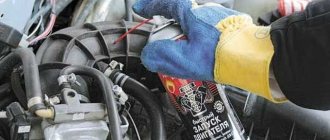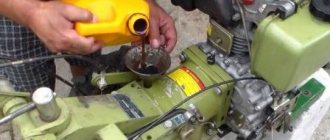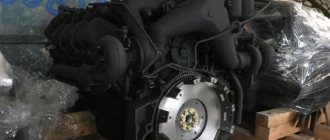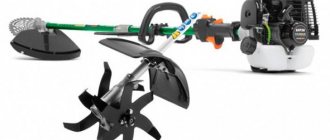Category: ENGINE
- Operating principle of "Quick start" for the engine
- Danger of use
- Product selection
- Liquid Liqui Moly "Start Fix"
- Liquid Mannol "Motor Starter 9669"
- Liquid HI-GEAR “Start Up”
- Using "Quick Start"
- "Extreme" methods of starting the engine
Operating a car in winter makes it difficult to start the engine; for this purpose, a liquid has been developed that guarantees a quick start for the engine at sub-zero temperatures. It is known that frost negatively affects the functionality of components and mechanisms, makes it impossible to maintain the required thermal conditions and thereby prevents the working mixture from igniting normally. Giving the product a “push” and igniting the first portion of fuel is the main task of such suspensions.
Having the product at hand gives the user confidence, since you don’t know where and at what moment trouble awaits. However, you shouldn’t rush headlong into the store and buy the first product you come across. The choice of fluid must be taken seriously; there are nuances in this matter that can harm the power motor. Let's try to understand the intricacies of the procedure.
Operating principle of "Quick start" for the engine
The liquid, which is used to quickly start the engine in winter, visually represents an aerosol placed in a can. The volatile substance contains: propane, butane, flammable ethers, alcohols, stabilizers and other additives. In addition, lubricants are added to the mixture, which eliminate the friction of the piston rings on the dry cylinder surface. The liquid introduced into the chamber gives the fuel present there an even greater ability to ignite.
The contents of the can can activate the power motor in conditions of fifty degrees below zero. Another feature is the stabilization of the combustible properties of fuel in humid climates or sudden temperature changes. In such conditions, condensation accumulated on electrical equipment does not allow the spark plugs to develop the necessary power so that the required charge is formed and the engine cannot be started without liquid.
Antigels or depressants
Such compositions help get rid of sediment in diesel fuel that forms at low temperatures. As soon as the thermometer drops below zero, the paraffins that make up diesel fuel begin to precipitate. When it gets colder, the paraffin molecules that make up diesel fuel begin the process of combining. When the maximum filterability temperature is reached, the fuel filter becomes clogged with gel-like paraffin, and fuel stops flowing into the engine. Depressant additives prevent the formation of a dense crystal lattice of paraffins - and further growth of their crystals stops.
Danger of use
Having become familiar with the principle of operation of the liquid, a reasonable question arises whether the use of an aerosol poses a threat to the motor. Its use increases the risk of breakdowns of some engine components and mechanisms. However, do not forget that the product is used in cases where other methods have failed, and you cannot do without a machine.
In addition, the danger lies in using the liquid without reading the instructions for use, which must be included with the product. Thus, exceeding the specified dose is the main mistake made by the user.
Despite the fact that advertising and official representatives of chemical companies declare complete safety, upon closer inspection, unpleasant nuances emerge; the truth lies in the composition of the substance. The fact is that the components included in the liquid are prone to “explosive” ignition, which causes increased detonation in the chamber. Having quickly started the engine once, the driver is unlikely to feel any negative consequences. However, repeated activation, or starting a worn-out unit, can cause destruction. In the “risk zone” are rings, valves, chambers, etc.
"Extreme" methods of starting the engine
There are situations when there is no liquid at hand to start the engine. I urgently need to start the car, but there is no store or people nearby. In such a scenario, proven methods will come to the rescue, which can only be used in emergency cases, but the driver must be aware of them.
Introducing a cube of gasoline into the engine intake tract:
Thus, starting a gasoline power plant is possible by injecting a cubic milliliter of gasoline (AI-92, 95) using a syringe. The motor is first cranked using 3-4 approaches of 5 seconds. The action drives stagnant oil through the circuit, preparing the installation for start-up. Afterwards, fuel is introduced into the air filter area and the engine is immediately started. With a successful combination of circumstances (working spark plugs and battery), the engine starts from the first seconds.
You can make your own quick start liquid. To do this, use kerosene, oil, gasoline or ether (instead of gasoline). You cannot use such products systematically, but in emergency situations the liquid will help.
Some first aid kits are equipped with a substance such as ether.
It is important to remember that the use of liquid entails such negative consequences as deformation of the rings, displacer, connecting rod and other related parts. Less risk when using the substance on diesel engines
Remember that the product must be administered in small doses, since the effect has a negative effect on the piston group.
Important! Before using the above methods, make sure that the oil and fuel equipment are working, otherwise attempts to restart the plant will be pointless actions
Pay attention to diesel engines; the fuel in these units is prone to freezing in cold weather.
It is noteworthy that the safe starting fluid for a diesel engine is silicone lubricant. The mixture is fed into the intake manifold continuously until the unit starts. The only condition for a successful procedure is the serviceability of the glow plugs, otherwise, the method of supplying an open flame to the inlet is used.
Spraying flammable liquid onto the engine carburetor:
The last method, which can only be used if the above mentioned products are not available, is a can of hairspray, deodorant or air freshener. The engine, when using these products, is able to start due to the presence of flammable gases in the mixture. True, it is worth resorting to this method in rare cases.
Please note that in normal condition the car starts without any means at hand. If you have to resort to “extreme” measures, the machine needs to identify problems and then correct the problem. This approach is preferable and the choice is made in favor of the latter.
Liquid Liqui Moly "Start Fix"
This German manufacturer, which produces products for starting the engine in winter, has done a better job than others in eliminating possible risks. The products are popular and in demand, this is explained by the well-balanced composition of the emulsion. Substances that are easily flammable are used in the manufacture; anti-erosion and lubricants are included.
Star Fix liquid can be poured into power plants that perform two and four strokes per operating cycle, as well as into rotary, diesel, and prechamber engines. The manufacturer also recommends using the liquid on lawn mowers, chainsaws, snowmobiles, motorcycles, etc. The minimum operating temperature is -50 degrees, use in a humid environment is possible. The volume of the cylinder is 200 ml (article 3902), the composition includes propane, butane, nitrogen.
Engine fluid "Star Fix":
Voltage instability
Sometimes, when the car is operating at low temperature conditions, a voltage drop is observed, and the unit cannot reach the required number of revolutions. The consequence of this is considered to be problematic engine starting. An explanation for the problem has been found: high humidity, which favors the unhindered “leaking” of the required voltage. The special product we offer can protect the battery contacts and easily remove excess moisture from the wires.
Malfunction of the gear is a very rare problem, and it is unlikely that an aerosol will help in solving the problematic issue.
Liquid Mannol "Motor Starter 9669"
The product, produced by a German manufacturer, is a popular and proven product. Thanks to the composition, it is possible to quickly start the engine in winter with minimal side effects. The liquid is economical and easy to use, equipped with a long tube that facilitates access to the installation. Area of application of the liquid: four-stroke engines running on gasoline, diesel, gas. In comparison with the previous product, the minimum temperature of use is -20 degrees, the product is placed in a cylinder with a volume of 450 ml (article 2136).
Which composition is best to choose to make it easier to start the engine?
Manufacturers of aerosols of this type are constantly creating various unique formulations in order to minimize all risks and at the same time attract the buyer. Although the choice of such “quick start” solutions is quite wide, it is worth highlighting the offers from Liqui Moly.
The composition is intended for gasoline and diesel engines. By the way, for diesel engines it is necessary to turn off glow plugs, heated flanges, etc. before use. The throttle should be in the maximum open position (the gas pedal is pressed all the way).
Also, in addition to Liqui Moly, Mannol Motor Starter, Hi-Gear means for quickly starting the engine, etc. should be highlighted. There are other solutions on the market, but as practice shows, it is better to give preference to well-known brands.
Even before purchasing, you need to pay attention to which internal combustion engine this or that composition is intended for. Solutions can be combined, involving use only in gasoline or diesel units, two-stroke, four-stroke, etc.
Liquid HI-GEAR “Start Up”
The products of the American company are successful in the automotive market. Winter engine starting fluid “Start Up” is suitable for use on both carburetor and injection engines running on diesel, gasoline, and gas. The peculiarity of the suspension is that the product is able to test individual elements of the installation’s power supply mechanism. The composition includes both gas components and a lubricant that eliminates friction in loaded areas. The volume of liquid sold in a cylinder is 286 ml (article HG3319).
Engine fluid “Start Up”:
It is worth noting that there are other manufacturers whose products meet established quality standards. However, the presented liquids are among the top three, and besides, fakes are rare, which is explained by the degrees of protection.
Tips and tricks
If we talk about practical operation, you should use aerosols and “quick start” liquids only if absolutely necessary. In other words, you should not use such compounds constantly.
It is important to understand that aerosols wash away the oil film and can also cause engine detonation
This is especially true for diesel engines, which operate somewhat differently than their gasoline counterparts. These units have glow plugs, not spark plugs, diesel fuel is ignited by compression and heat, and not by a spark on the spark plug, etc.
We also add that you should not use liquid for an easy start according to the “more is better” principle. Excessive amounts of flammable compound can result in shock loads, which greatly increases the risk of serious engine damage.
Taking into account that the engine is in good working order, this approach will relieve the owner of difficulties and problems with starting the engine even in difficult conditions, while the load on the starter and wear during a cold start will be minimal.
Use of anti-wear, anti-smoke and other additives to reduce oil consumption. Pros and cons after applying the additive to the engine.
Low compression in engine cylinders: the main reasons. How to increase engine compression without engine repair, available methods. Tips and tricks.
How fuel cleaning additives work, testing and choosing an injector and engine combustion chamber cleaner. Effect of additives on gasoline. Tips and tricks.
Protective and restorative additives for engines: operating principle. In what cases are oil additives used, what to expect after use.
Flushing compositions for cleaning the Hi-Gear engine lubrication system: features, advantages and disadvantages of Hi-Gear flushes. Useful tips for flushing the internal combustion engine.
Lavr engine oil system cleaner: advantages, disadvantages, application features. Washing Laurel, test in practice, tips and tricks.
Operating a car in winter makes it difficult to start the engine; for this purpose, a liquid has been developed that guarantees a quick start for the engine at sub-zero temperatures. It is known that frost negatively affects the functionality of components and mechanisms, makes it impossible to maintain the required thermal conditions and thereby prevents the working mixture from igniting normally. Giving the product a “push” and igniting the first portion of fuel is the main task of such suspensions.
Having the product at hand gives the user confidence, since you don’t know where and at what moment trouble awaits. However, you shouldn’t rush headlong into the store and buy the first product you come across. The choice of fluid must be taken seriously; there are nuances in this matter that can harm the power motor. Let's try to understand the intricacies of the procedure.
Using "Quick Start"
Having bought a can of liquid for the first time, the user does not know where to spray the composition and how to use it correctly. We advise you to read the instructions immediately, since the composition of each drug is different.
Standard procedure:
- Shake the container of “quick start” liquid for the motor;
- Spray the contents into the engine intake manifold (2-3 seconds);
- Try starting the engine without pressing the gas pedal.
When carrying out the manipulation, remember that the task of spraying is to deliver part of the liquid into the combustion chamber of the engine. The mixture must get there along with air, which will support combustion. If the initial quick start operation for a gasoline engine is unsuccessful, the liquid is sprayed into the carburetor a second time, while the throttle and air valves are opened. Some manufacturers recommend applying the composition to the air filter, or removing the element by spraying liquid into the air intake mechanism. Such actions are permissible, subject to compliance with safety rules and a careful approach.
Injecting fluid into the engine manifold:
It is important that the procedure is carried out 2 times, no more, otherwise damage to the parts and mechanisms of the motor may occur. It is advisable to have an assistant present to start the car from the cab.
When trying to start a diesel engine, the glow plugs must be turned off. Otherwise, an explosion will occur in antiphase, which will cause damage to the unit. Remember, not every diesel engine, so don’t be lazy to read the instructions.
In winter, in cold weather, owners have a desire to use the launcher every day. However, this should not be done under any circumstances. Remember that the mixture is a “one-time” way out of a situation when there is no time to find out the main cause of the problem. A technically sound car starts without any assistance. Carry the liquid with you as an option in case of emergency and remember that work with the suspension is carried out in the open air of open fire sources.
How to use it correctly
Find your air filter - these are the devices on all cars that allow the engine to mix air with fuel, making combustion possible. The air filter will always be attached to the engine and located under the hood. But different manufacturers manufacture their vehicles using different technologies, so the air filter on different cars may be located in different places. To locate it, refer to your vehicle's owner's manual.
Spray a small amount of aerosol into the air filter. Hold the starting fluid bottle vertically. Point the can nozzle at the air filter from a distance of approximately 20 centimeters. Spray the engine to quickly start the engine for about two seconds, then try to start it. If the engine still does not start, repeat the Quick Start spray procedure for 2 seconds. To do this, you need to remove the air filter cover. If the car does not start even after using the Quick Start, you should contact your mechanic. If the engine does not start even with the correct application of starting fluid, the problem may not be the engine itself. For example, the ignition or some other system may be faulty.
Four-stroke engines
Quick Start is sprayed onto the engine near the air filter, carburetor hole or engine spark plug hole to quickly add fuel to the combustion cylinder. Using starting fluid to speed up the engine helps prevent wear on the starter, especially on rarely used vehicles. Other uses include cold weather starting, vehicles that are starved of fuel and therefore require extra time to repressurize, and sometimes with flooded engines. Mechanics sometimes use a spray to diagnose starting problems, determining whether the vehicle's spark and ignition system is working; if the spark is sufficient but the fuel supply system is missing, the engine will run until the quick start vapor is consumed. Most often the product is used with fuel injection systems
When using starting fluid on diesel engines that have a preheating system, care must be taken as rapid starting may catch fire, causing engine damage.
Two-stroke engines
Quick Start is not recommended for regular use on some two-stroke engines as it does not have lubricating properties on its own. Lubrication for two-stroke engines is achieved using oil that is either mixed with the fuel or automatically introduced into the fuel supply system; engines that require preliminary injection of fuel are started exclusively at a quick start and do not receive sufficient lubricant supply to the cylinder(s). Engines that have not been started for a long time are especially vulnerable; Quick Start is a strong solvent and removes residual oil, further reducing lubrication in the absence of fuel.











